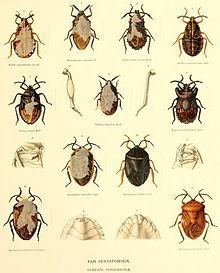Order True bugs | Infraorder Pentatomomorpha Scientific name Dinidoridae Rank Family | |
 | ||
Similar Urostylididae, True bugs, Termitaphididae, Aenictopecheidae | ||
The Dinidoridae are a small family of insects comprising about a hundred species in sixteen genera in the Hemipteran suborder Heteroptera, the "true bugs". As a group the family does not have any common name. Until the late 19th century they were generally regarded as a subfamily of the Pentatomidae.
Contents
Description
Most members of the family Dinidoridae are large and robust in build; the bodies of some species may exceed 27 mm in length. In shape they are ovoid to oblong. The head and pronotum have lateral keels. The scutellum is moderately short and blunt, typically some 50% of the abdominal length.
The antennae have four or five segments, with at least two of the subapical segments more or less flattened. The antenniferous tubercles are set below the lateral head margins, and are not visible from above. The tarsi have two or three segments. In most genera trichobothria occur in pairs on the third to the seventh abdominal sterna, but Eumenotes species have only one trichobothrium per segment. Each pair of trichobothria is arranged transversely on a large callus mesad of the abdominal spiracles.
Taxonomy
The taxon corresponding to the modern family Dinidoridae was originally established by Stål in 1870 as the subfamily Dinidorida of the family Pentatomidae. Subsequent authorities such as Lethierry and Severin applied the name Dinidoridae, but in a subfamily sense in spite of the implication of the suffix "-dae". Twentieth century authorities treated the Dinidoridae as a distinct family, which now is the established view.
Two subfamilies are generally recognised, the Dinidorinae and the Megymeninae. They may be distinguished as follows:
The Dinidorinae includes two tribes: The Dinidorini and the Thalmini. The Dinidorini comprise several genera and tens of species, some with four-segmented and some with five-segmented antennae. The tribe Thalmini contains three species, each in its own genus. All three species have two-segmented tarsi.
In the subfamily Megymeninae the lateral margins of the abdomen and commonly also of the head and pronotum are produced into lobes, tubercles, or spines. In many species the pronotum bears a dorsal anteromedian tuberosity, or a posterior transverse ridge. In most species the legs are heavily and strongly spined; in others the antennae and legs are setulose.
Two tribes were recognized within the Megymeninae, one of them being the Megymenini; in the tribe Megymenini The genus Doesbergiana includes only one species. The genus Megymenum; however; has 15 described species. Several species have expanded pronotal margins and some have reduced hemelytra and are flightless. In most species the second valvifers are reduced, lightly sclerotized, and fused mesally.
Work continues in establishing the taxonomy of the family in the light of molecular genetics. Current evidence suggests that Dinidoridae is in fact monophyletic and is a sister group to the Tessaratomidae. However the monogeneric tribe Eumenotini, including only the monotypic genus Eumenotes Westwood, had been seen as belonging in the Megymeninae. This however no longer seems defensible. The tribe actually looks closer to the Dinidorinae, but whether it should be assigned to Dinidorinae or to its own subfamily needs separate consideration.
Biology
All Dinidoridae appear subsist strictly on the sap of host plants in various families, more than twenty in number. Known hosts include members of the following families, on some of which some of the species are recognised as pests:
Distribution
Dinidoridae occur mainly in far-eastern and African regions, but the genus Dinidor occurs in neotropical regions and species of Megymenum extend down to Australia.
